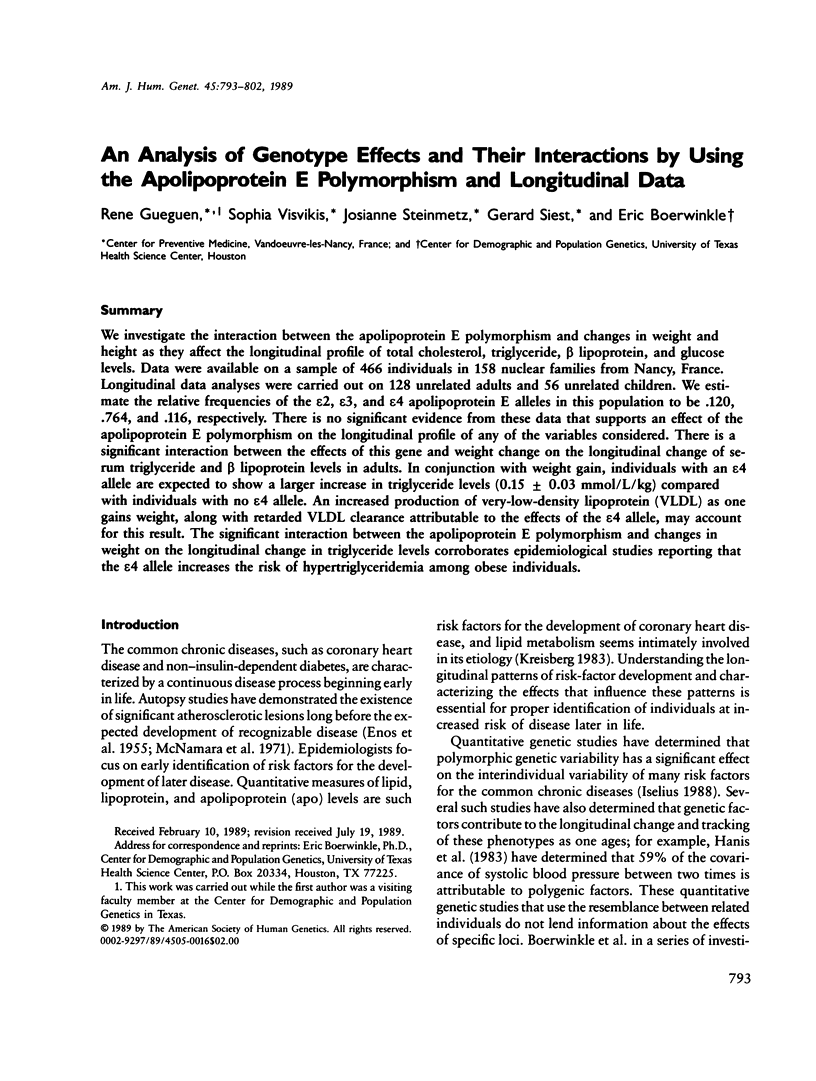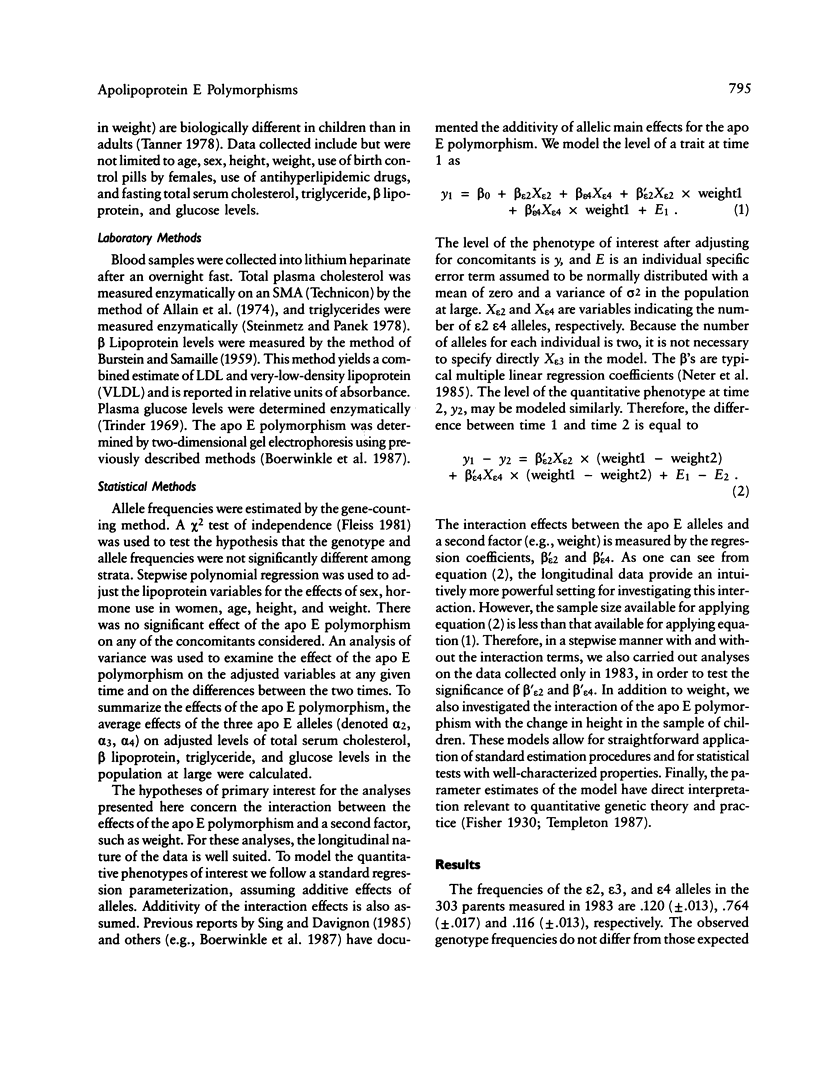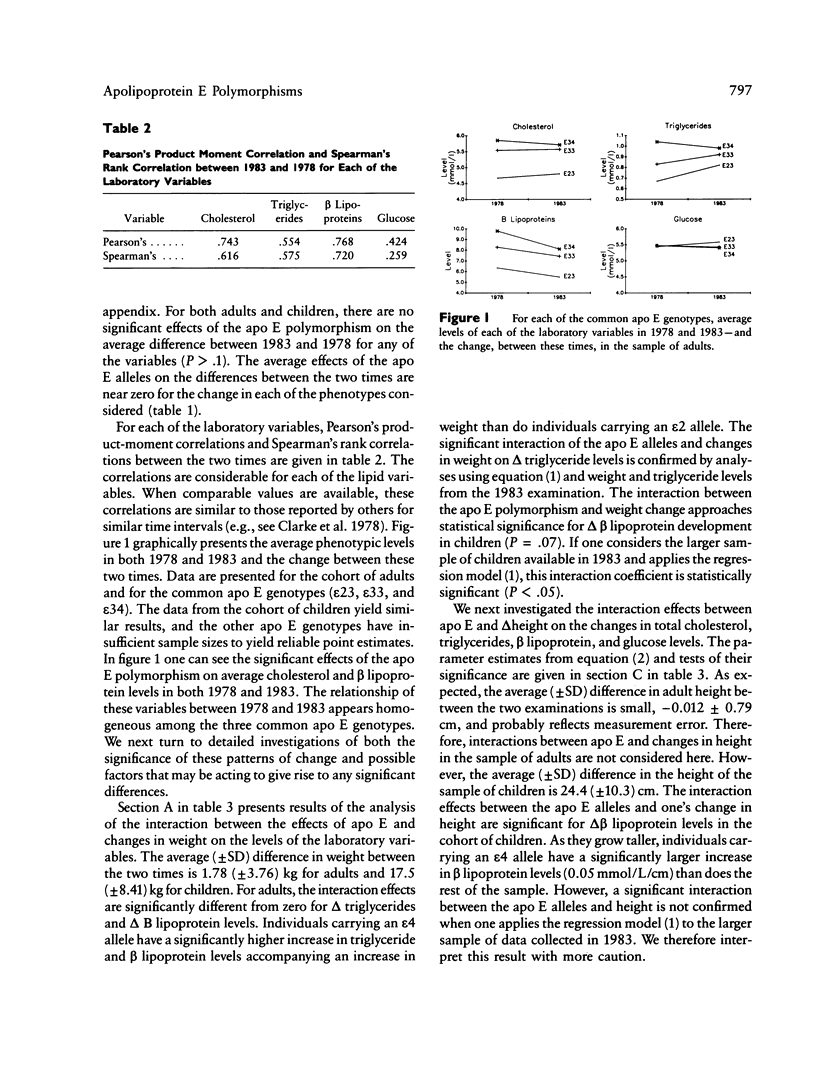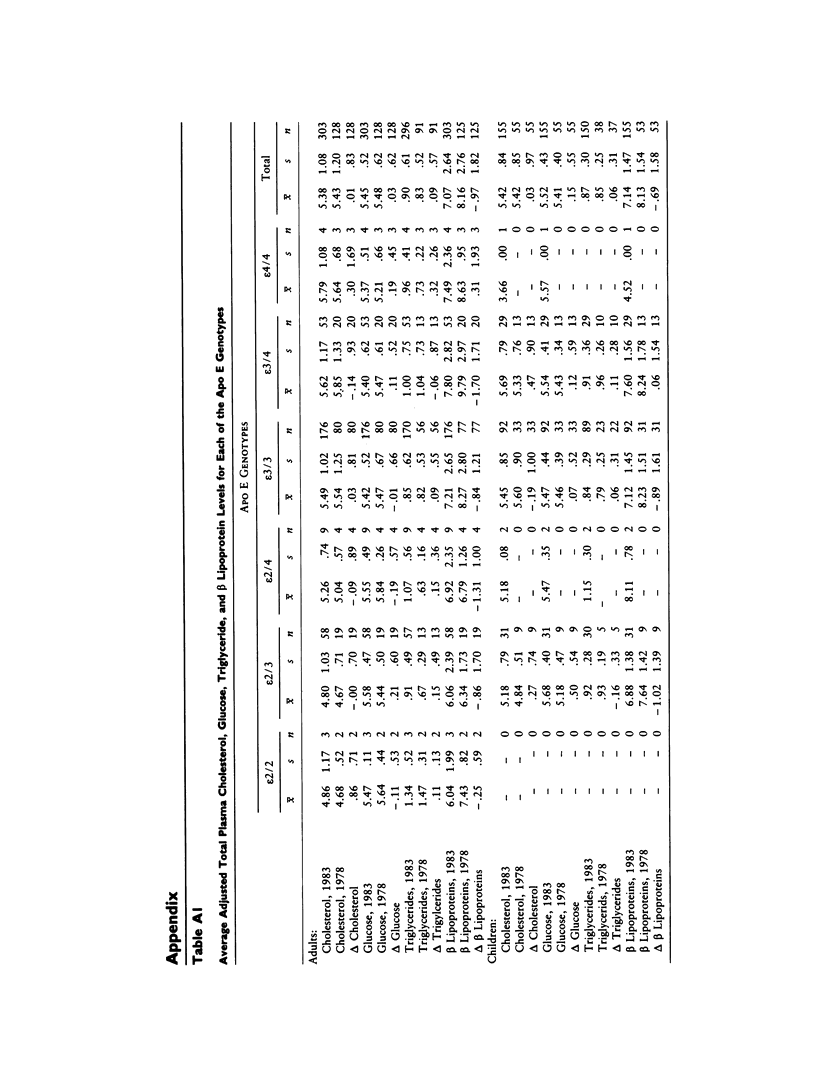Abstract
We investigate the interaction between the apolipoprotein E polymorphism and changes in weight and height as they affect the longitudinal profile of total cholesterol, triglyceride, beta lipoprotein, and glucose levels. Data were available on a sample of 466 individuals in 158 nuclear families from Nancy, France. Longitudinal data analyses were carried out on 128 unrelated adults and 56 unrelated children. We estimate the relative frequencies of the epsilon 2, epsilon 3, and epsilon 4 apolipoprotein E alleles in this population to be .120, .764, and .116, respectively. There is no significant evidence from these data that supports an effect of the apolipoprotein E polymorphism on the longitudinal profile of any of the variables considered. There is a significant interaction between the effects of this gene and weight change on the longitudinal change of serum triglyceride and beta lipoprotein levels in adults. In conjunction with weight gain, individuals with an epsilon 4 allele are expected to show a larger increase in triglyceride levels (0.15 +/- 0.03 mmol/L/kg) compared with individuals with no epsilon 4 allele. An increased production of very-low-density lipoprotein (VLDL) as one gains weight, along with retarded VLDL clearance attributable to the effects of the epsilon 4 allele, may account for this results. The significant interaction between the apolipoprotein E polymorphism and changes in weight on the longitudinal change in triglyceride levels corroborates epidemiological studies reporting that the epsilon 4 allele increases the risk of hypertriglyceridemia among obese individuals.
Full text
PDF









Selected References
These references are in PubMed. This may not be the complete list of references from this article.
- Allain C. C., Poon L. S., Chan C. S., Richmond W., Fu P. C. Enzymatic determination of total serum cholesterol. Clin Chem. 1974 Apr;20(4):470–475. [PubMed] [Google Scholar]
- Angel A. Pathophysiologic changes in obesity. Can Med Assoc J. 1978 Dec 23;119(12):1401–1406. [PMC free article] [PubMed] [Google Scholar]
- BURSTEIN M., SAMAILLE J. Nouvelle methode de séparation et de dosage des lipoprotéines de faible densité. Ann Biol Clin (Paris) 1959 Jan-Feb;17(1-2):23–34. [PubMed] [Google Scholar]
- Bell G. I., Karam J. H., Rutter W. J. Polymorphic DNA region adjacent to the 5' end of the human insulin gene. Proc Natl Acad Sci U S A. 1981 Sep;78(9):5759–5763. doi: 10.1073/pnas.78.9.5759. [DOI] [PMC free article] [PubMed] [Google Scholar]
- Boerwinkle E., Chakraborty R., Sing C. F. The use of measured genotype information in the analysis of quantitative phenotypes in man. I. Models and analytical methods. Ann Hum Genet. 1986 May;50(Pt 2):181–194. doi: 10.1111/j.1469-1809.1986.tb01037.x. [DOI] [PubMed] [Google Scholar]
- Boerwinkle E., Sing C. F. The use of measured genotype information in the analysis of quantitative phenotypes in man. III. Simultaneous estimation of the frequencies and effects of the apolipoprotein E polymorphism and residual polygenetic effects on cholesterol, betalipoprotein and triglyceride levels. Ann Hum Genet. 1987 Jul;51(Pt 3):211–226. doi: 10.1111/j.1469-1809.1987.tb00874.x. [DOI] [PubMed] [Google Scholar]
- Boerwinkle E., Utermann G. Simultaneous effects of the apolipoprotein E polymorphism on apolipoprotein E, apolipoprotein B, and cholesterol metabolism. Am J Hum Genet. 1988 Jan;42(1):104–112. [PMC free article] [PubMed] [Google Scholar]
- Boerwinkle E., Visvikis S., Welsh D., Steinmetz J., Hanash S. M., Sing C. F. The use of measured genotype information in the analysis of quantitative phenotypes in man. II. The role of the apolipoprotein E polymorphism in determining levels, variability, and covariability of cholesterol, betalipoprotein, and triglycerides in a sample of unrelated individuals. Am J Med Genet. 1987 Jul;27(3):567–582. doi: 10.1002/ajmg.1320270310. [DOI] [PubMed] [Google Scholar]
- Boerwinkle E., Xiong W. J., Fourest E., Chan L. Rapid typing of tandemly repeated hypervariable loci by the polymerase chain reaction: application to the apolipoprotein B 3' hypervariable region. Proc Natl Acad Sci U S A. 1989 Jan;86(1):212–216. doi: 10.1073/pnas.86.1.212. [DOI] [PMC free article] [PubMed] [Google Scholar]
- Bouthillier D., Sing C. F., Davignon J. Apolipoprotein E phenotyping with a single gel method: application to the study of informative matings. J Lipid Res. 1983 Aug;24(8):1060–1069. [PubMed] [Google Scholar]
- Clarke W. R., Schrott H. G., Leaverton P. E., Connor W. E., Lauer R. M. Tracking of blood lipids and blood pressures in school age children: the Muscatine study. Circulation. 1978 Oct;58(4):626–634. doi: 10.1161/01.cir.58.4.626. [DOI] [PubMed] [Google Scholar]
- Cooper D. N., Clayton J. F. DNA polymorphism and the study of disease associations. Hum Genet. 1988 Apr;78(4):299–312. doi: 10.1007/BF00291724. [DOI] [PubMed] [Google Scholar]
- Davignon J., Gregg R. E., Sing C. F. Apolipoprotein E polymorphism and atherosclerosis. Arteriosclerosis. 1988 Jan-Feb;8(1):1–21. doi: 10.1161/01.atv.8.1.1. [DOI] [PubMed] [Google Scholar]
- ENOS W. F., Jr, BEYER J. C., HOLMES R. H. Pathogenesis of coronary disease in American soldiers killed in Korea. J Am Med Assoc. 1955 Jul 16;158(11):912–914. doi: 10.1001/jama.1955.02960110018005. [DOI] [PubMed] [Google Scholar]
- Eaves L. J. The resolution of genotype x environment interaction in segregation analysis of nuclear families. Genet Epidemiol. 1984;1(3):215–228. doi: 10.1002/gepi.1370010302. [DOI] [PubMed] [Google Scholar]
- Eto M., Watanabe K., Iwashima Y., Morikawa A., Oshima E., Sekiguchi M., Ishii K. Apolipoprotein E phenotypes and plasma lipids in young and middle-aged subjects. Tohoku J Exp Med. 1986 Jan;148(1):25–34. doi: 10.1620/tjem.148.25. [DOI] [PubMed] [Google Scholar]
- Gianturco S. H., Gotto A. M., Jr, Hwang S. L., Karlin J. B., Lin A. H., Prasad S. C., Bradley W. A. Apolipoprotein E mediates uptake of Sf 100-400 hypertriglyceridemic very low density lipoproteins by the low density lipoprotein receptor pathway in normal human fibroblasts. J Biol Chem. 1983 Apr 10;258(7):4526–4533. [PubMed] [Google Scholar]
- Gregg R. E., Zech L. A., Schaefer E. J., Stark D., Wilson D., Brewer H. B., Jr Abnormal in vivo metabolism of apolipoprotein E4 in humans. J Clin Invest. 1986 Sep;78(3):815–821. doi: 10.1172/JCI112645. [DOI] [PMC free article] [PubMed] [Google Scholar]
- Hanis C. L., Sing C. F., Clarke W. R., Schrott H. G. Multivariate models for human genetic analysis: aggregation, coaggregation, and tracking of systolic blood pressure and weight. Am J Hum Genet. 1983 Nov;35(6):1196–1210. [PMC free article] [PubMed] [Google Scholar]
- Harris A., Lankester S., Haan E., Beres J., Hulten M., Szollar J., Souttier L., Bobrow M. The gene for incontinentia pigmenti: failure of linkage studies using DNA probes to confirm cytogenetic localization. Clin Genet. 1988 Jul;34(1):1–6. doi: 10.1111/j.1399-0004.1988.tb02607.x. [DOI] [PubMed] [Google Scholar]
- Howard B. V., Abbott W. G., Egusa G., Taskinen M. R. Coordination of very low-density lipoprotein triglyceride and apolipoprotein B metabolism in humans: effects of obesity and non-insulin-dependent diabetes mellitus. Am Heart J. 1987 Feb;113(2 Pt 2):522–526. doi: 10.1016/0002-8703(87)90625-9. [DOI] [PubMed] [Google Scholar]
- Hui D. Y., Innerarity T. L., Mahley R. W. Defective hepatic lipoprotein receptor binding of beta-very low density lipoproteins from type III hyperlipoproteinemic patients. Importance of apolipoprotein E. J Biol Chem. 1984 Jan 25;259(2):860–869. [PubMed] [Google Scholar]
- Kesaniemi Y. A., Grundy S. M. Increased low density lipoprotein production associated with obesity. Arteriosclerosis. 1983 Mar-Apr;3(2):170–177. doi: 10.1161/01.atv.3.2.170. [DOI] [PubMed] [Google Scholar]
- Kreisberg R. A. Lipids, lipoproteins, apolipoproteins, and atherosclerosis. Ann Intern Med. 1983 Nov;99(5):713–715. doi: 10.7326/0003-4819-99-5-713. [DOI] [PubMed] [Google Scholar]
- Mahley R. W. Apolipoprotein E and cholesterol metabolism. Klin Wochenschr. 1983 Mar 1;61(5):225–232. doi: 10.1007/BF01496128. [DOI] [PubMed] [Google Scholar]
- Martin N. G., Clark P., Ofulue A. F., Eaves L. J., Corey L. A., Nance W. E. Does the PI polymorphism alone control alpha-1-antitrypsin expression? Am J Hum Genet. 1987 Mar;40(3):267–277. [PMC free article] [PubMed] [Google Scholar]
- McNamara J. J., Molot M. A., Stremple J. F., Cutting R. T. Coronary artery disease in combat casualties in Vietnam. JAMA. 1971 May 17;216(7):1185–1187. [PubMed] [Google Scholar]
- Nikkilä E. A., Kekki M. Measurement of plasma triglyceride turnover in the study of hyperglyceridemia. Scand J Clin Lab Invest. 1971 Apr;27(2):97–104. doi: 10.3109/00365517109080194. [DOI] [PubMed] [Google Scholar]
- Orr J. D., Sing C. F., Moll P. P. Analysis of genetic and environmental sources of variation in serum cholesterol in Tecumseh, Michigan--VI. A search for genotype by environment interaction. J Chronic Dis. 1981;34(11):545–559. doi: 10.1016/0021-9681(81)90017-5. [DOI] [PubMed] [Google Scholar]
- Schneider W. J., Kovanen P. T., Brown M. S., Goldstein J. L., Utermann G., Weber W., Havel R. J., Kotite L., Kane J. P., Innerarity T. L. Familial dysbetalipoproteinemia. Abnormal binding of mutant apoprotein E to low density lipoprotein receptors of human fibroblasts and membranes from liver and adrenal of rats, rabbits, and cows. J Clin Invest. 1981 Oct;68(4):1075–1085. doi: 10.1172/JCI110330. [DOI] [PMC free article] [PubMed] [Google Scholar]
- Sing C. F., Davignon J. Role of the apolipoprotein E polymorphism in determining normal plasma lipid and lipoprotein variation. Am J Hum Genet. 1985 Mar;37(2):268–285. [PMC free article] [PubMed] [Google Scholar]
- Steinmetz J., Panek E. Adaptation sur GSA II Greiner du dosage des triglycérides par voie entièrement enzymatique application à l'étude de leur conservation et de certaines interférences analytiques. J Clin Chem Clin Biochem. 1978 Nov;16(11):613–619. [PubMed] [Google Scholar]
- Trinder P. Determination of blood glucose using 4-amino phenazone as oxygen acceptor. J Clin Pathol. 1969 Mar;22(2):246–246. doi: 10.1136/jcp.22.2.246-b. [DOI] [PMC free article] [PubMed] [Google Scholar]
- Utermann G., Hees M., Steinmetz A. Polymorphism of apolipoprotein E and occurrence of dysbetalipoproteinaemia in man. Nature. 1977 Oct 13;269(5629):604–607. doi: 10.1038/269604a0. [DOI] [PubMed] [Google Scholar]


